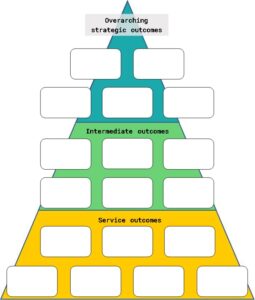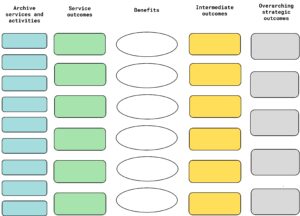Main section
The following examples suggest ideas to help you create an archives outcomes framework for stronger and safer communities. Don’t be constrained by them; you can refer to the examples as much or as little as you want.
Ideally your outcomes framework will consist of four elements:
- Outcomes triangle
- Logic model
- Evidence
- Performance indicators
Tabs Navigation
Tabs
Outcomes triangle and logic model
Outcomes triangle
The outcomes triangle gives an overview of how archives can contribute at service, intermediate and overarching strategic outcome levels.

The outcomes triangle model
Outcomes could be:
Overarching strategic outcomes
- Strong and resilient communities
- Sustainable and thriving neighbourhoods
- A greater sense of place and increased civic pride
- Equitable and integrated communities
Intermediate outcomes
- Tackling the fear of crime and anti-social behaviour
- More people participating in local decision making
- Increased philanthropy and giving
- Greater diversity of people participating in local decision making
- Improved understanding of cultural diversity, identity and shared heritage
Service outcomes
- More people accessing information about local decision making
- Increased skills and capacity amongst local heritage organisations
- Increased acknowledgement that archives contribute to a sense of place
- More people volunteering and involved in community life through archives
- Increased engagement by young people and adults facing inequalities
Logic model
The logic model illustrates the main links between service activities and local outcomes. This example suggest broad groupings of activities, benefits archives can offer to individuals, communities and places, and how these in turn contribute to the achievement of intermediate and overarching strategic outcomes.

A logic model template
Outcomes could be:
Archive activities
- Facilities and information provision
- Volunteering opportunities
- Training, employment and mentoring schemes
- Support for community groups
- Management, conservation and preservation of collections
- Development and outreach work
- Events, sessions and clubs
Service outcomes
- Increased acknowledgment that archives contribute to a sense of place
- More people volunteering and involved in community life through archives
- Increased skills and capacity among local heritage organisations
- More people accessing information about local decision making
- Increased engagement by young people and adults facing inequalities
Benefits
- Improved cultural infrastructure, image and identity
- Increased capacity and improved service provision
- Increased confidence, self-esteem, personal responsibility and resilience
- Increased social interaction, new relationships and role models
- Increased understanding of local services and community issues
- Stronger identification with local community and increased respect for others
Intermediate outcomes
- Increased philanthropy and giving
- More sustainable services or parent organisation
- Improved understanding of cultural diversity, identity and shared heritage
- Greater diversity of people participating in local decision making
- Tackling the fear of crime amd anti-social behaviour
Overarching strategic outcomes
- Sustainable and thriving neighbourhoods
- Strong and resilient communities
- A greater sense of place and increased civic pride
- Equitable and integrated communities
Our section on ‘What to include‘ has more information about the outcomes triangle and logic model methods
Step two of ‘Creating your framework‘ features a step by step guide to creating an outcomes triangle and logic model
Evidence
The evidence section of the framework underpins the outcomes triangle and logic model. It lists the sources of evidence that together best demonstrate the contribution of archives to the outcomes.
We have identified some examples of validated national evidence that demonstrate the contribution of archives to outcomes for stronger and safer communities. You may have other examples relevant to your local outcomes.
Stage three of ‘Creating your framework‘ contains a step-by-step guide to reviewing the evidence
‘Large cultural infrastructure projects’ (The National Archives, 2023)
This guidance highlights how archive services can be valuable partners in the delivery of large cultural infrastructure projects, with their collections able to inspire, inform, and enrich project programming. There are a number of success stories included that show how archives celebrate communities and create a positive legacy in local areas.
Workforce development case studies (The National Archives, various dates)
A series of case studies from across the UK, some of which focus on volunteering and feature the positive impact for archives and include a range of testimonials highlighting the benefits experienced by the volunteers themselves.
Workforce development – on the National Archives website
Making archive services more inclusive (The National Archives, various dates)
A series of case studies highlighting the impact of making collections more inclusive by improving representation of diverse communities, highlighting underrepresented voices, revealing previously hidden histories and giving them new value and meaning for people.
‘The impact of volunteering in archives‘ (Archives & Records Association, 2018)
Research highlighting the impacts of volunteering in archives and how these affect volunteers, services, and the profession. Volunteers feel the long-term effects of improved health and well-being, new and re-enforced skills and enhanced prospects of employability.
The impact of volunteering in archives – on the Archives and Records Association website
‘The Economic Impact of the UK Heritage Tourism Economy’ (Oxford Economics, 2016)
This study examines gives an indication of the scale of the gross economic impact of heritage tourism in the UK in terms of visit numbers, visit spend, employment and GDP. Then, comparisons are made with other sectors of the UK economy.
The Economic Impact of the UK Heritage Tourism Economy on the Oxford Economics website
Performance indicators
Below are suggestions of how to measure the contribution of archives to better outcomes across a number of policy themes. Not all of these suggestions will be relevant to your local outcomes.
You should select a small number of indicators from across the different levels that together best measure the contribution of archives to your service, intermediate and overarching strategic outcomes. Draw on available data from existing sources within your local council or organisation and elsewhere wherever possible.
Stage four of ‘Creating your framework’ has a step-by-step guide to selecting performance indicators
Overarching strategic outcome indicators
These are high-level non-archive indicators that you want to demonstrate, and can evidence that archives contribute towards. They are likely to reflect the overall responsibilities of key decision-makers; notably local government, but also other key stakeholder groups such as your community cohesion or community safety partnership.
Examples include:
- Percentage of local authority budgets delegated to local decision making
- Percentage of people involved in social action in their community
- Percentage of people who feel they can influence decisions in their local area
- Overall and or general satisfaction with local area
- Percentage of people who believe people from different backgrounds get on well together in their local area
- Levels of anti-social behaviour
- Percentage of juvenile offenders re-offending and frequency of re-offending per 100 offenders
- Re-offending rate of prolific and other priority offenders
- Number of first time entrants to the criminal justice system aged 10 to 17
- Overall crime rates
Some of these indicators may be drawn from non-council data sources.
Intermediate outcome indicators
These should include indicators that reflect the specific contribution of archives to the intermediate outcomes.
Examples include:
- Number of:
- full-time equivalent (FTE) jobs supported by the archive visitor economy
- community organisations involved with the local archive assets and facilities
- people who think that the archive helps make their local area a nicer place to live and or contributes to local identity and pride
- Percentage of people who agree that:
- participation in an archives project, activity or event has helped make them feel part of their community
- participation in an archives project, activity or event has helped improve their confidence, self-esteem, communication or social skills
- participation in an archives project, activity or event has encouraged people to respect and trust each other or have more respect for their area
- participation in an archives project, activity or event has helped build positive relationships between local people
- participation in an archives project, activity or event has helped increase their understanding of how they can influence decisions in their neighbourhood or get involved in local decision making
- participation in an archives project, activity or event has made them want to get more involved in community social action or volunteering
- children and young people who agree that participation in an archive project, activity or event has helped them do something positive in their free time or stay out of trouble
- % residents satisfied with their built environment
Intermediate outcome indicators may also include non-archive indicators that are short to medium term ‘proxy’ measures for the overarching strategic outcomes.
Examples include:
- Growth in tourism per year and visitor spend (£ million)
- Percentage of young people participating in positive activities
- Percentage of young people, adults or older people participating in social action or regular volunteering
- Social connectedness
Service outcome indicators
These are indicators specific to archives.
Examples include:
- Archive services achieving Archive Service Accreditation
- Facilities and services with a recognised design or environmental sustainability award
- Percentage of:
- children and young people, adults or older people accessing the archive
- participants who agree that participation in an archive project or event has been enjoyable
- young people, adults or older people regularly volunteering in the archive
- children and young people, adults or older users satisfied with the archive provision in their local area
- residents who agree they have influenced archive provision in their area
- residents who agree that archive provision, activities or events have increased their understanding of the local heritage
- increase in jobs in the heritage economy
- tourists who include archive facilities or events among their reasons for visiting
- Number of:
- participants who agree that participation in an archive project, activity or event has contributed to the survival and/or accessibility of local heritage
- participants who agree that participation in an archive project, activity or event has increased their involvement in their local heritage
Service output indicators
These indicators are also specific to archives.
Examples include:
- Number of:
- young people and adults or older people participating in archive activities, project or events
- visits or participants in the archive offer (per 1,000 population)
- children and young people participating in archive activities during the school holidays
- young people at risk of offending engaged in positive activities through the archive
- young people, adults or older people participating in archive outreach activities
- young people, adults or older people regularly volunteering in the archive
- people accessing the archive service for the first time
- local organisations supported to gain skills
- Number of uses of the archive as a venue for community activities
- Percentage of visitors making repeat visits/use of the archive service
- Net expenditure on archive provision per head of population.
- Percentage of the population living within ‘x’ miles radius of archive facilities
- Percentage of users satisfied with archive facilities, services or events
- Comparability of facilities, activities or events user profiles with resident profiles
Where useful indicators can be broken down further, for example, by geographic area or target wards or by specific groups, including different age groups or disadvantaged and or vulnerable groups.